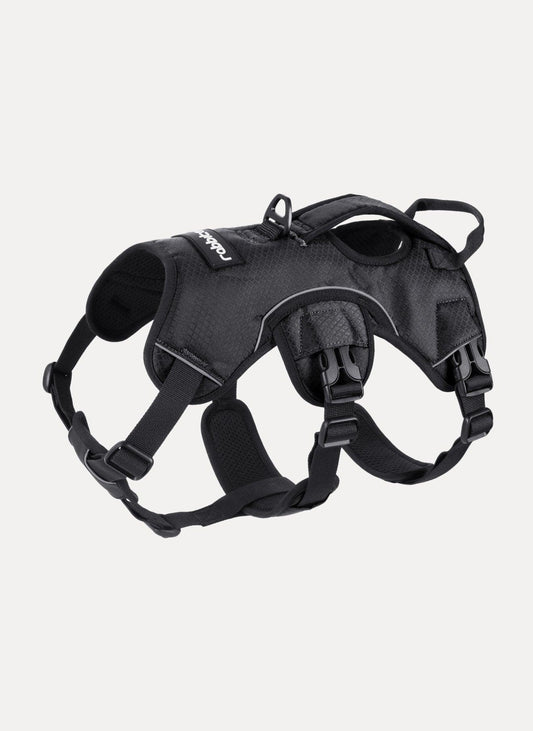The Ultimate Guide to Cat Harness Training for Beginners
Training a cat to wear harness seems a difficult task, because most cats will appear "cat going limp" moment. Cats will be nervous and scared because the uncomfortable wear so that they will walk on sloping feet makes them look weaker to avoid getting hurt.
However, the good news is that such behavior can be corrected and it requires the cat owners to have enough patience and focus on cat harness training. Here’s how to train your cat to wear a cat harness!
Why your cat need cat harness and leash?
A cat harness, as the name suggests, is a piece of equipment designed for cats to use when they are walking out.
Unlike dogs, cats are “freedom lovers” and are more agile than dogs. When cats are out, they love to burrow into bushes, pipes, or dark and small places on the side of the road. When they find such an interesting place they will quick run into and will not hesitate to leave their cat owner behind. Add to this the fact that cats are smaller, more agile, and their fur is softer, making it harder for cat owners to react and retrieve them once they've escaped.
So whether you're taking your cat out for a walk or leaving it to play in the backyard, a cat harness and leash are indispensable.
What you need to prepare before training?
Choose one comfortable and safe cat harness
In order to ease your cat's uneasy tension and anxiety, and allow him to get used to wearing a cat harness faster, it is crucial to choose the right cat harness, which should be comfortable, lightweight, and secure. So how to choose one suitable cat harness?
|
Tips for choose cat harness
|
|
For your pet's safety and comfort, check out Rabbitgoo escape proof cat harness. It comes with four adjustable straps, uses breathable mesh fabric, and is specially made with a no-choke design to protect your cat's neck from the stress of the leash pulling.
Choose a quiet and familiar environment for training
Cats have a very sensitive sense of hearing and smell, and they will be on high alert when they enter a new environment. Cat harness is new to cats, some kittens will show curiosity and enthusiasm, while others will show strange fear. When we want to carry out cat harness training for them, the new environment and new things may bring great pressure to the cats, and some kittens may even cause tragedy due to stress.
Therefore, when training cats to wear and adapt to the cat harness, you can choose to do it in a familiar and quiet indoor environment. A familiar environment with a familiar cat owner may also increase the kitten's confidence!
Prepare your cat's favorite snacks
Just as parents teach their children, parents reward their children when they successfully accomplish something, overcome a fear, or develop a good habit. Cat owners can also prepare rewards for their cats as they familiarize with the harness, after they put it on, and after they get used to it. A cat's favorite snack can be a very good choice. Unlike cat toys, who may make your cat move and run around, cat snacks can keep your little furry pet stationary and slowly acclimatize to the harness.
How to train your cat to wear a cat harness?
Training your cat to wear a harness is a process that requires patience, cats may be resistant to the harness, here are the detailed steps to train your cat to wear a harness:
Step #1: Familiarize with the harness
First, you can put the harness in the place where your cat often stays, such as the cat's bed, the cat tree, or any corner of your home that he likes to be next to, so that your cat can slowly familiarize herself with the harness. During this period, pay attention to the cat's reaction to the harness. If your cat shows curiosity or interest, you can take a snack as a reward to help your cat build positive associations.
Step #2: Brief contact
Once your cat has become familiar with the harness, you can begin to try gently placing the harness on your cat's body. However, be careful to make only a brief contact and then remove it immediately. After each contact, do not forget to reward and praise your cat, as this will enable it to establish a more positive association.
Step #3: Extend the contact time
When the cat slowly does not feel afraid or avoid the presence of the harness, you can gradually extend the contact time between the harness and the cat. Slowly start to increase from a few seconds to a few minutes. During this process, the cat may appear to resist, so please be sure to maintain a patient and gentle attitude and avoid forcing the cat to accept the harness.
Step #4: Put on the harness gradually
When your cat is no longer resistant to the contact of the harness, you can start to choose to let your cat wear the cat harness! After putting on the harness, you can wear it for only one minute, and then gradually increase the wearing time. At the same time, you can let your cat walk around the house while wearing the harness to help your cat get used to the feel of the harness.
Step #5: Consolidate the training results
After the cat has adapted to wearing the harness at home, it is also important to continue the training. Be careful to observe the cat's reaction and physical condition to ensure its safety and comfort.
Final Thoughts
Training your cat to wear a harness is not as impossible as the legend says, but it needs cat owners have enough patience. From choosing a harness to training, every step of the process requires the cat owner to be careful and meticulous. By allowing the cat to gradually familiarize itself with the harness and then adapt to it, one thing that should not be left out of these steps is to reward the cat with its favorite snacks. So they can establish a positive association with the harness.
Each step is indispensable and must not be forgotten, and hope this article will be of substantial use in cat harness training!





